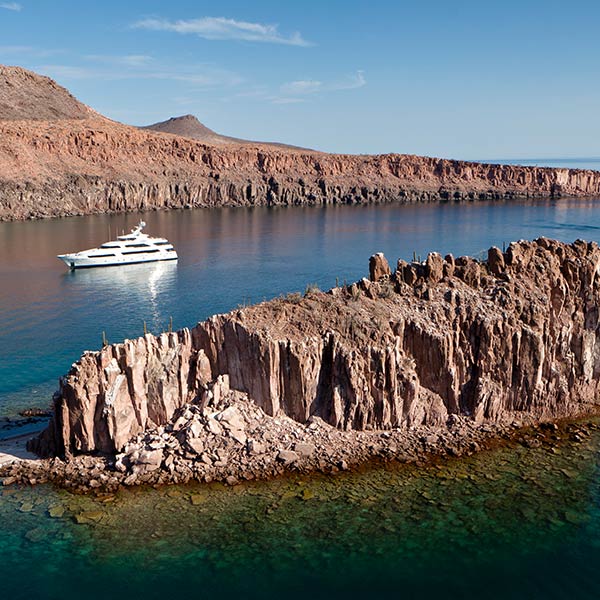
Esthec

Esthec
Superyachting’s teak solution
Teak has long been the timber of choice for yacht decks, exterior furniture and interior finishes, but environmental, ethical and humanitarian concerns are forcing a change – and the superyacht industry is leading the charge to find alternatives.
Superyachts are frequently cited as being the very height of luxury, and a key part of that is the materials that are used on board. For decades, teak has been the wood of choice for superyacht decks for a number of reasons – its looks, its feel underfoot, and its resilience to the harsh marine environment and saltwater makes it the perfect material for use inside and out, and as deck furniture.
But teak has a problem. The slow-growing hardwood so prized by yacht builders and furniture makers and myriad more has, for many years, been the focus of concerns about its sustainability and the ethical and humanitarian impacts of its harvesting. The best teak always came from the forests in Myanmar, but concerns over teak being used to finance the military junta, as well as unscrupulous logging that, says the Environmental Investigation Industry (EIA), means the country will lose its forests by 2035, has led to restrictions on the import and sale of Myanmar teak in the US, UK, EU and Switzerland since 2021.
There are an increasing number of plantations in Asia, South America and elsewhere that are aiming to replace the in-demand Myanmar teak with a sustainably grown and harvested fast-growing teak, but it doesn’t have the density of the old growth – which can take 80 years or more to mature – and it can still be difficult to prove what teak has come from where leading to legal and ethical nightmares for owners and yachtbuilders.
So what is the superyacht industry doing to both change the narrative on deck materials away from teak, while at the same time highlighting that it is not only an industry that takes its ethical responsibilities seriously but also is at the forefront of using pioneering new teak alternatives harvested from sustainable forests or produced in sustainable ways?

Tesumo Photo: Peter Seyferth

Tesumo Photo: Peter Seyferth
Finding a synthetic solution
The answer is manyfold, it turns out, and yachting has not been standing idly by ignoring the teak crisis that has been heading its way. For one, several companies have sprouted over the past two decades who have developed synthetic decking alternatives.
Chief among them is Esthec, founded in 2007, which uses heat-hardened material that offers several benefits over teak, including remaining cooler in the sun and being more resilient which makes it perfect for working areas such as helidecks. It also comes in a variety of colours and styles, so it’s not just about matching the look of teak but about creating an holistic colour and look to an entire vessel. Co-founder Marcel van der Spek is also at pains to point out that Esthec is made using biomaterials and all raw materials are sourced regionally to the factory to reduce the company’s CO2 footprint.
Natural alternatives
But while manmade teak alternatives offer one solution, there are other avenues that are opening up as yachtbuilders and outdoor furniture makers alike look to natural alternatives. For one, there’s nothing that quite matches the feel of real wood under your feet – and in an industry that focuses on aesthetic and sensation as much as it increasingly thinks about sustainability, perception of owners and guests is everything.
Tallulah Chapman, communications manager at the Forest Stewardship Council (FSC) UK, for example suggests acacia for outdoor furniture, although it does need resealing each season; she also points to bamboo, particularly for interiors – a material that has seen increasing use on superyachts for interior flooring.
For decking, however, the demands are far more stringent, and a lot of alternative woods are simply not up to the challenge. A handful of companies and partnerships are making headway in developing treated woods that, they say, make perfect replacements for teak decking. Marine Maple has developed a heat treatment process for American hard maple – a wood that is both sustainable and has a zero-carbon footprint – that it says is aesthetically and functionally similar to teak for decking. “It has been used on passerelles, tenders, swimming platforms and so on, so it has already been proven as an alternative,” offers Alan Muir, sales manager at Modesty Yacht Carpentry which specialises in teak and marine maple for yachts.

Tesumo

Tesumo
New processes for new solutions
Cork is another wood that has been used for superyacht decks, although not in the wine-bottle-stopper form that we are most familiar. Ground up and mixed with a binder to create a material that can be cut into planks or sheets. With several companies already offering products – including Marinedeck 2000, SeaCork and AquaCork – the material already has a following on superyacvhts.
Similarly, an alternative teak product is also emerging as a contender, which uses reject parts of the teak tree to create thin veneers that are then laminated together and cut into planks that almost exactly resemble a traditional teak plank.
Perhaps most interesting is the arrival of Tesumo, another treated hardwood that has been developed from a research project by German superyacht builder Lürssen in partnership with Georg-August University in Göttingen, Germany and Wolz Nautic, a superyacht decking specialist also based in Germany. The wood is sourced from managed forests which have FSC or OLB (Origine et Légalité des Bois) certificates, and offers the same appearance, resilience and rot resistance as teak thanks to the patented process that applies heat treatment and resin infusion to the wood.
It’s something that has already caught the attention of owners. “The aesthetics are remarkably similar to teak,” says the owner of SY Gulliver. “It feels great and performs excellently.”

Esthec on ISA yacht Okto

Esthec on ISA yacht Okto
More recently, Tesumo has been selected for the groundbreaking Project Zero superyacht currently under construction at the Vitters shipyard in the Netherlands, with Marnix Hoekstra of Dutch design and naval architecture Vripack stating that it is the future of decking.
“The basics for Tesumo were developed in the Wood Biology and Wood Products department at Georg-August University,” says Professor Dr Holger Militz, the department’s head. “The aim was to create a real alternative to teak for use as a high-quality wooden deck on yachts. The properties required in the project have been confirmed in scientific tests in the lab and in practical use – Tesumo’s combination of hardness, dimensional stability, durability and resistance to cracking are the most important characteristics of this new material.”
With such a wide variety of alternatives already on the market and already proving their worth on superyachts and superyacht tenders, the superyacht industry is embracing the change and the move away from teak. In doing so, it is not only helping develop and prove the viability of alternatives that can be used by other industries, it is also helping to redefine the idea of what luxury on a superyacht really is. It’s a definition that is slowly morphing to be conditional on sustainable and ethical considerations – and that’s a change in attitude that should be widely celebrated.



